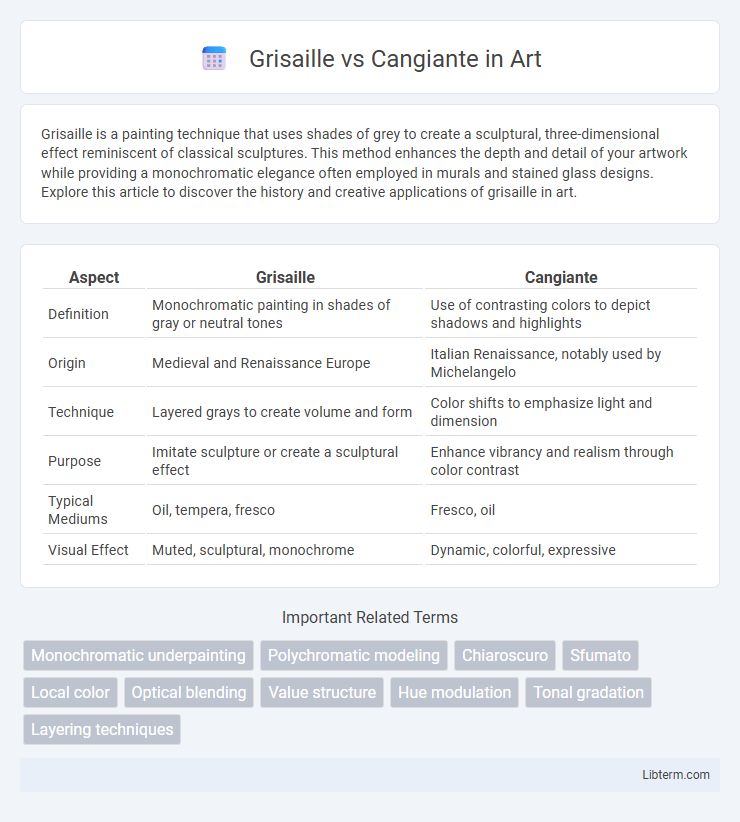Grisaille is a painting technique that uses shades of grey to create a sculptural, three-dimensional effect reminiscent of classical sculptures. This method enhances the depth and detail of your artwork while providing a monochromatic elegance often employed in murals and stained glass designs. Explore this article to discover the history and creative applications of grisaille in art.
Table of Comparison
| Aspect | Grisaille | Cangiante |
|---|---|---|
| Definition | Monochromatic painting in shades of gray or neutral tones | Use of contrasting colors to depict shadows and highlights |
| Origin | Medieval and Renaissance Europe | Italian Renaissance, notably used by Michelangelo |
| Technique | Layered grays to create volume and form | Color shifts to emphasize light and dimension |
| Purpose | Imitate sculpture or create a sculptural effect | Enhance vibrancy and realism through color contrast |
| Typical Mediums | Oil, tempera, fresco | Fresco, oil |
| Visual Effect | Muted, sculptural, monochrome | Dynamic, colorful, expressive |
Introduction to Grisaille and Cangiante Techniques
Grisaille is a painting technique using shades of gray to create a monochromatic effect that emphasizes form and light without color distractions. Cangiante, a Renaissance method, employs vibrant color shifts to depict highlights and shadows when tonal variation within a single hue is limited. These distinct approaches showcase artists' skill in manipulating color and tone to enhance depth and dimensionality.
Historical Origins: Grisaille and Cangiante in Art History
Grisaille originated in medieval European art as a monochromatic painting technique using shades of gray to imitate sculpture and create depth, prominently featured in Gothic altarpieces and illuminated manuscripts. Cangiante, emerging during the Italian Renaissance, is characterized by abrupt shifts in color to depict light and shadow when tonal variation is limited, famously employed by masters such as Michelangelo in frescoes like the Sistine Chapel ceiling. Both techniques represent historical explorations of color and form, with Grisaille emphasizing tonal gradation and sculptural illusion, while Cangiante embodies a vibrant approach to color modulation in high Renaissance painting.
What is Grisaille? Definition and Process
Grisaille is a painting technique executed entirely in shades of gray to create a monochromatic image that emphasizes form and volume through tonal variations. The process involves applying layers of gray paint, often using oil or tempera, to build depth and simulate sculptural effects, making it ideal for underpainting or standalone works. This method enhances three-dimensionality and detail by carefully modulating light and shadow without the distraction of color.
What is Cangiante? Definition and Approach
Cangiante is a Renaissance painting technique characterized by the use of different hues to depict variations of light and shadow rather than relying solely on tonal changes. It employs contrasting colors, often shifting from green to yellow or red to orange, to create dynamic visual effects and enhance volume in a composition. This approach differs from Grisaille, which uses monochromatic shades of gray to simulate sculpture or relief.
Key Differences Between Grisaille and Cangiante
Grisaille is a monochromatic painting technique using shades of gray to create the illusion of sculpture and depth, often employed in underpainting or decorative elements. Cangiante emphasizes bold color shifts, where artists switch to contrasting hues to depict shadows and highlights instead of using traditional shading methods. The key difference lies in Grisaille's reliance on tonal variation within a single color, while Cangiante prioritizes vibrant color contrasts to convey volume and light effects.
Notable Artists Who Used Grisaille
Notable artists who used grisaille include Jan van Eyck, Leonardo da Vinci, and Albrecht Durer, each employing this monochromatic painting technique to create detailed, sculptural effects reminiscent of stone or metal reliefs. Grisaille, characterized by its use of shades of gray to simulate three-dimensionality, contrasts with cangiante, which emphasizes vibrant color shifts to depict light and shadow. This technique was especially prominent in Northern Renaissance art and illuminated manuscripts, showcasing artists' mastery in tonal variation without relying on color.
Famous Examples of Cangiante in Art
Famous examples of cangiante in art include Michelangelo's Sistine Chapel ceiling, where vibrant color shifts enhance the figures' volume and emotion. Raphael's frescoes in the Vatican also showcase cangiante through contrasting hues that create dynamic light effects. This technique contrasts with grisaille, which limits itself to monochromatic, grayscale palettes to simulate sculpture.
Visual Effects: Tonal vs. Color Contrasts
Grisaille technique emphasizes tonal contrasts by using varying shades of gray to create depth and form, resulting in subtle, monochromatic visual effects. Cangiante relies on bold color contrasts by shifting hues to depict light and shadow, producing vibrant and dynamic visual impact. These methods offer distinct visual experiences: Grisaille's tonal modulation fosters a sculptural quality, while Cangiante's color shifts enhance expressiveness and dimensionality through chromatic variation.
Applications in Modern and Classical Painting
Grisaille, a monochromatic painting technique using shades of gray, is widely applied in classical art to create detailed underpaintings and sculptural effects, often serving as a preliminary layer for glazing. Cangiante, characterized by shifting colors to depict light and shadow rather than relying on tonal variation, finds its primary use in Renaissance frescoes and modern interpretative works to enhance vibrancy and dynamic visual contrasts. Both techniques continue to influence contemporary artists, with Grisaille employed for tonal studies and depth, while Cangiante inspires bold color transitions and expressive compositions.
Choosing Between Grisaille and Cangiante: Artistic Considerations
Choosing between Grisaille and Cangiante involves understanding their distinct artistic effects: Grisaille uses monochromatic tones to create a sculptural illusion, emphasizing form and light, while Cangiante employs vibrant contrasting colors to enhance volume and emotional impact. Artists prioritizing subtle detail and tonal harmony often prefer Grisaille for its capacity to evoke depth without color distraction. Conversely, those seeking dynamic and expressive color shifts choose Cangiante to highlight dramatic transitions and emphasize the interplay of light and shadow.
Grisaille Infographic

 libterm.com
libterm.com